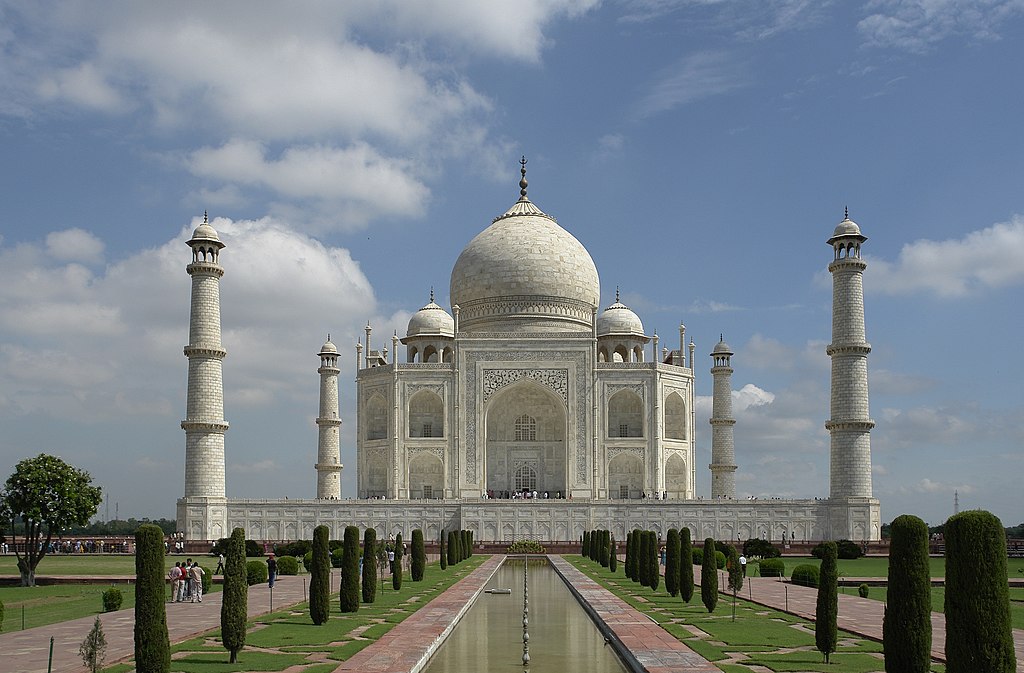Key Takeaways
- Taj Mahal’s 20 rooms to be open to find Hindu scripts and idols a petition filed in Allahabad High Court and Allahabad Court seeks directives of Archaeological Survey of India(ASI).
About Taj Mahal
- Location – Agra , Uttar Pradesh
- Built by – Mughal emperor Shahjahan in memory of his wife Mumtaz Mahal and it also contains the tomb of Shah Jahan himself.
- Brick used – White Ivory Marble
- Associated River – Yamuna
- The Taj Mahal was built over the course of 17 years, from 1631 to 1648 AD.
- In December 1920, the Taj Mahal was designated as a nationally significant centrally protected monument.
- It was inscribed on the list of UNESCO World Heritage Sites in 1983, and is considered one of the Seven Wonders of the World.
Architecture of Taj Mahal
- The Taj compound is reached through a massive red sandstone entrance with a stunning entry arch that frames the mausoleum.
- The tomb is set in a Chahar Bagh (garden), which is crisscrossed with walks and water courses, with pools and fountains intermingled.
- The tomb’s plinth is reached along a straight passage through the bagh.
- Four one hundred and thirty-two foot tall minarets stand at the corners of the terrace.
- The building’s main body is capped with a drum, a dome, and four cupolas, creating a stunning skyline.
- To maintain balance, a red sandstone mosque is located to the west of the white marble-faced tomb, while a similar structure is located to the east.
- The marble for the Taj Mahal was quarried in Rajasthan’s Makrana Mines.
- The mausoleum’s interior features a crypt below and a vaulted, octagonal tomb chamber with rooms at each angle, all connected by passageways.
- The carved and perforated Jalis positioned in the arched recesses of the interior provide light to every area of the structure.
- The Taj Mahal’s interior and external surfaces have been embellished with four different styles of decorations.
- These include high and low relief stone carvings on the walls, delicate marble carvings into jails and graceful volutes (spiral ornament on the pillars), and the production of arabesque with pietra dura on walls and tombstones, as well as geometric designs with tessellation.
- To connect Quranic texts, calligraphy is combined with jasper inlay in white marble.
- Calligraphy serves as an aesthetic element on the walls as well as a constant link to the almighty.
Threats Faced by Taj Mahal

Features of Indo-Islamic Architecture
- Islamic kings built minars around mosques and mausoleums.
- The mortar was used as a cementing agent during construction.
- No human or animal figures were employed in the construction procedure.
- In contrast to previous buildings that used sculptures, calligraphy became increasingly prominent.
- Space, mass, and breadth were introduced to Indo-Islamic architecture.
- In architecture, geometry was used as a decorative theme. The geometrical vegetal ornamentation of the Arabesque style gained favour.
- Arabesque was marked by a continuous stem that split regularly, generating a sequence of counterpoised, leafy secondary stems, and was defined by geometrical vegetal embellishments. As a result, the subsidiary stems divide or rejoin the main stem, generating a decorative pattern.
- The constructions were embellished with intricate “jali” art, which symbolised the importance of light in Islamic traditions.
- The importance of water was also visible in the structure. It was largely used for religious, artistic, and cooling purposes.
- The charbagh method, which divides a garden into four half, the Pietra dura kind of stone and gem inlay on stone walls, and the foreshortening technique, which makes inscriptions appear closer than they are
Other Mughal Architectures and Rulers
| Mughal Architectures | Rulers |
| Akbar’s Tomb | Jahangir |
| Bibi ka Maqbara | Aurangazeb |
| Red Fort | Shah Jahan |
| Agra Fort | Akbar |
| Jama Masjid, Delhi | Shah Jahan |
Content Source : Hindustan Times



